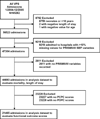Children with chronic illness return to their baseline functional status after organ dysfunction on the first day of admission in the pediatric intensive care unit
- PMID: 20223474
- PMCID: PMC4406357
- DOI: 10.1016/j.jpeds.2009.12.029
Children with chronic illness return to their baseline functional status after organ dysfunction on the first day of admission in the pediatric intensive care unit
Abstract
Objective: To determine chronic illness outcomes after admission with multiple organ dysfunction syndrome (MODS) for patients in the pediatric intensive care unit (PICU).
Study design: We evaluated consecutive PICU admissions from 35 US children's hospitals from January 2004-December 2005 in the virtual PICU Performance System database. We excluded hospitals with >10% missing values for MODS variables and patients<1 month or>18 years of age. MODS was identified by laboratory and vital sign values from day of admission with International Pediatric Sepsis Consensus Conference criteria. Chronic illness was identified by secondary diagnoses, classified by modified Delphi method. We evaluated functional outcomes with pediatric overall performance category and pediatric cerebral performance category scores from PICU admission and discharge.
Results: Of 44 693 admissions, 52.1% had a chronic diagnosis. Chronic diagnoses increased MODS at PICU admission (24.6% vs 12.0%, P<.001) and mortality rates (3.7% vs 1.9%, P<.001). Patients with a chronic diagnosis had similar changes in pediatric overall performance category and pediatric cerebral performance category scores from PICU admission to discharge as previously healthy children. However, outcome in different chronic diagnosis categories was variable.
Conclusions: Chronic illness increased MODS incidence at PICU admission and impacted all-cause PICU mortality rates. Although, in aggregate, children who survive return to baseline functional status, this varies by chronic illness category.
Copyright (c) 2010 Mosby, Inc. All rights reserved.
Conflict of interest statement
The authors declare no conflicts of interest.
Figures



Similar articles
-
Outcomes of Day 1 Multiple Organ Dysfunction Syndrome in the PICU.Pediatr Crit Care Med. 2019 Oct;20(10):914-922. doi: 10.1097/PCC.0000000000002044. Pediatr Crit Care Med. 2019. PMID: 31589198 Free PMC article.
-
Day 1 multiple organ dysfunction syndrome is associated with poor functional outcome and mortality in the pediatric intensive care unit.Pediatr Crit Care Med. 2009 Sep;10(5):562-70. doi: 10.1097/PCC.0b013e3181a64be1. Pediatr Crit Care Med. 2009. PMID: 19741445 Free PMC article.
-
Epidemiology and outcomes of multiple organ dysfunction syndrome following pediatric trauma.J Trauma Acute Care Surg. 2022 Dec 1;93(6):829-837. doi: 10.1097/TA.0000000000003616. Epub 2022 Apr 1. J Trauma Acute Care Surg. 2022. PMID: 35358103 Free PMC article.
-
Severity of illness and organ dysfunction scoring in children.Pediatr Crit Care Med. 2005 May;6(3 Suppl):S126-34. doi: 10.1097/01.PCC.0000161287.61028.D4. Pediatr Crit Care Med. 2005. PMID: 15857545 Review.
-
The pediatric multiple organ dysfunction syndrome.Pediatr Crit Care Med. 2009 Jan;10(1):12-22. doi: 10.1097/PCC.0b013e31819370a9. Pediatr Crit Care Med. 2009. PMID: 19057438 Review.
Cited by
-
Outcomes of Day 1 Multiple Organ Dysfunction Syndrome in the PICU.Pediatr Crit Care Med. 2019 Oct;20(10):914-922. doi: 10.1097/PCC.0000000000002044. Pediatr Crit Care Med. 2019. PMID: 31589198 Free PMC article.
-
Epidemiology and Outcomes of Pediatric Multiple Organ Dysfunction Syndrome.Pediatr Crit Care Med. 2017 Mar;18(3_suppl Suppl 1):S4-S16. doi: 10.1097/PCC.0000000000001047. Pediatr Crit Care Med. 2017. PMID: 28248829 Free PMC article. Review.
-
Epidemiology of Pediatric Critical Illness in a Population-Based Birth Cohort in Olmsted County, MN.Pediatr Crit Care Med. 2017 Mar;18(3):e137-e145. doi: 10.1097/PCC.0000000000001084. Pediatr Crit Care Med. 2017. PMID: 28125547 Free PMC article.
-
Chronic conditions among children admitted to U.S. pediatric intensive care units: their prevalence and impact on risk for mortality and prolonged length of stay*.Crit Care Med. 2012 Jul;40(7):2196-203. doi: 10.1097/CCM.0b013e31824e68cf. Crit Care Med. 2012. PMID: 22564961 Free PMC article.
-
Causes of death in critically ill paediatric patients in Japan: a retrospective multicentre cohort study.BMJ Paediatr Open. 2019 Aug 19;3(1):e000499. doi: 10.1136/bmjpo-2019-000499. eCollection 2019. BMJ Paediatr Open. 2019. PMID: 31531406 Free PMC article.
References
-
- Dosa NP, Boeing NM, Ms N, Kanter RK. Excess risk of severe acute illness in children with chronic health conditions. Pediatrics. 2001 Mar;107(3):499–504. - PubMed
-
- Briassoulis G, Filippou O, Natsi L, Mavrikiou M, Hatzis T. Acute and chronic paediatric intensive care patients: current trends and perspectives on resource utilization. QJM. 2004 Aug;97(8):507–518. - PubMed
-
- Marcin JP, Slonim AD, Pollack MM, Ruttimann UE. Long-stay patients in the pediatric intensive care unit. Crit Care Med. 2001 Mar;29(3):652–657. - PubMed
-
- Mestrovic J, Kardum G, Polic B, Mestrovic M, Markic J, Sustic A, et al. The influence of chronic health conditions on susceptibility to severe acute illness of children treated in PICU. Eur J Pediatr. 2006 Aug;165(8):526–529. - PubMed
Publication types
MeSH terms
Grants and funding
LinkOut - more resources
Full Text Sources
Other Literature Sources
Medical

